Action Learning to Support Development of Subject Specific Pedagogy
VerifiedAdded on 2020/10/23
|16
|5290
|426
Report
AI Summary
This report delves into the critical issue of bullying within secondary education, employing an action learning approach to investigate its causes, effects, and potential solutions. The study begins with a background on the prevalence of bullying and its negative impacts on students, including mental health issues such as depression and anxiety. The report outlines the research questions, rationale, and methodology used, which includes both primary and secondary research techniques. A literature review explores the factors that provoke bullying, the influence of drugs, alcohol, and sexual activities on teenagers, and methods for preventing bullying and addressing the health concerns it causes. The report also includes professional debates and peer discussions, providing diverse perspectives on the topic. The findings of the report highlight the importance of addressing bullying to ensure a safe and healthy educational environment for students, with recommendations for schools, educators, and parents to take proactive measures. This report aims to contribute to a better understanding of bullying and its impact on students' well-being.
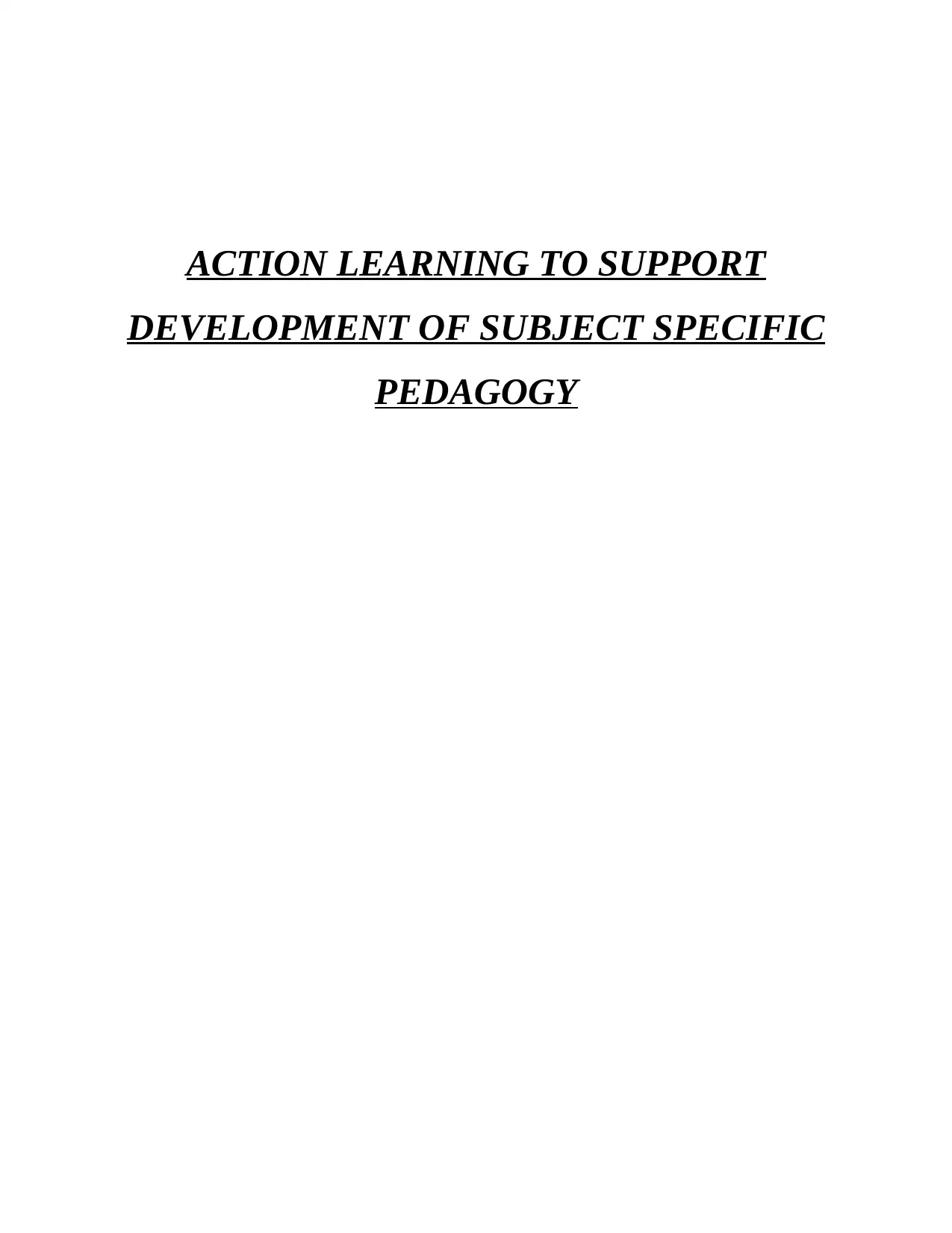
ACTION LEARNING TO SUPPORT
DEVELOPMENT OF SUBJECT SPECIFIC
PEDAGOGY
DEVELOPMENT OF SUBJECT SPECIFIC
PEDAGOGY
Paraphrase This Document
Need a fresh take? Get an instant paraphrase of this document with our AI Paraphraser
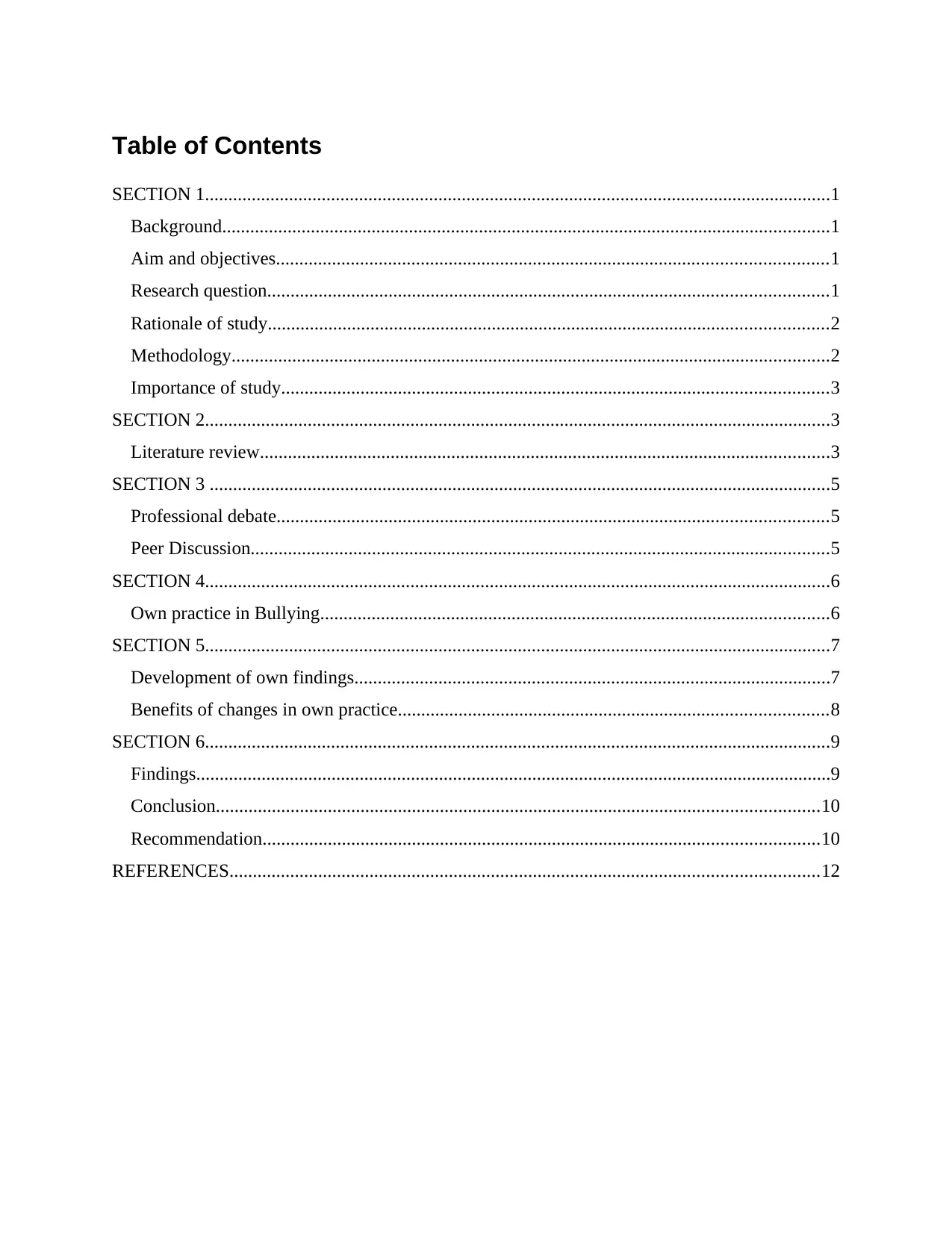
Table of Contents
SECTION 1......................................................................................................................................1
Background..................................................................................................................................1
Aim and objectives......................................................................................................................1
Research question........................................................................................................................1
Rationale of study........................................................................................................................2
Methodology................................................................................................................................2
Importance of study.....................................................................................................................3
SECTION 2......................................................................................................................................3
Literature review..........................................................................................................................3
SECTION 3 .....................................................................................................................................5
Professional debate......................................................................................................................5
Peer Discussion............................................................................................................................5
SECTION 4......................................................................................................................................6
Own practice in Bullying.............................................................................................................6
SECTION 5......................................................................................................................................7
Development of own findings......................................................................................................7
Benefits of changes in own practice............................................................................................8
SECTION 6......................................................................................................................................9
Findings........................................................................................................................................9
Conclusion.................................................................................................................................10
Recommendation.......................................................................................................................10
REFERENCES..............................................................................................................................12
SECTION 1......................................................................................................................................1
Background..................................................................................................................................1
Aim and objectives......................................................................................................................1
Research question........................................................................................................................1
Rationale of study........................................................................................................................2
Methodology................................................................................................................................2
Importance of study.....................................................................................................................3
SECTION 2......................................................................................................................................3
Literature review..........................................................................................................................3
SECTION 3 .....................................................................................................................................5
Professional debate......................................................................................................................5
Peer Discussion............................................................................................................................5
SECTION 4......................................................................................................................................6
Own practice in Bullying.............................................................................................................6
SECTION 5......................................................................................................................................7
Development of own findings......................................................................................................7
Benefits of changes in own practice............................................................................................8
SECTION 6......................................................................................................................................9
Findings........................................................................................................................................9
Conclusion.................................................................................................................................10
Recommendation.......................................................................................................................10
REFERENCES..............................................................................................................................12
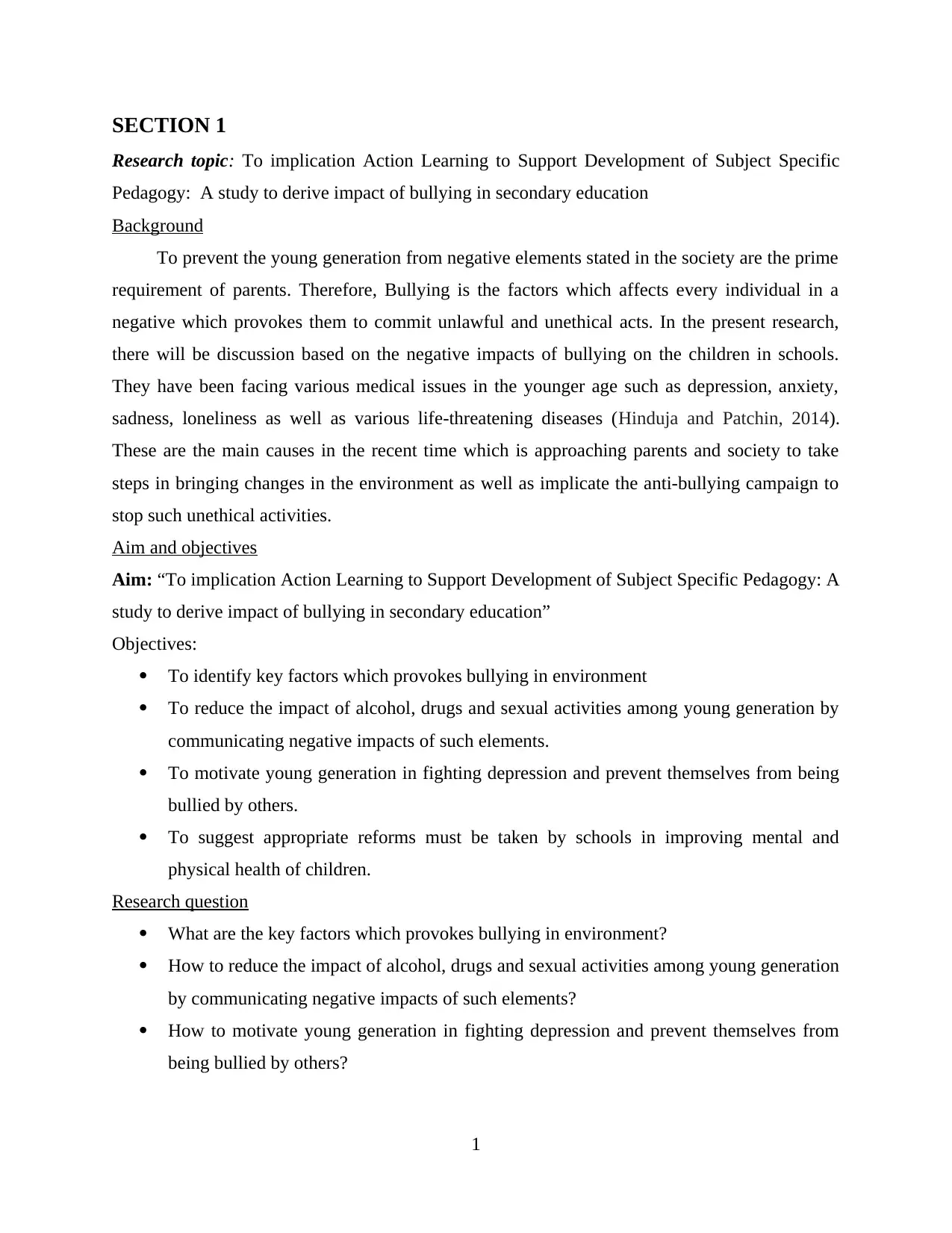
SECTION 1
Research topic: To implication Action Learning to Support Development of Subject Specific
Pedagogy: A study to derive impact of bullying in secondary education
Background
To prevent the young generation from negative elements stated in the society are the prime
requirement of parents. Therefore, Bullying is the factors which affects every individual in a
negative which provokes them to commit unlawful and unethical acts. In the present research,
there will be discussion based on the negative impacts of bullying on the children in schools.
They have been facing various medical issues in the younger age such as depression, anxiety,
sadness, loneliness as well as various life-threatening diseases (Hinduja and Patchin, 2014).
These are the main causes in the recent time which is approaching parents and society to take
steps in bringing changes in the environment as well as implicate the anti-bullying campaign to
stop such unethical activities.
Aim and objectives
Aim: “To implication Action Learning to Support Development of Subject Specific Pedagogy: A
study to derive impact of bullying in secondary education”
Objectives:
To identify key factors which provokes bullying in environment
To reduce the impact of alcohol, drugs and sexual activities among young generation by
communicating negative impacts of such elements.
To motivate young generation in fighting depression and prevent themselves from being
bullied by others.
To suggest appropriate reforms must be taken by schools in improving mental and
physical health of children.
Research question
What are the key factors which provokes bullying in environment?
How to reduce the impact of alcohol, drugs and sexual activities among young generation
by communicating negative impacts of such elements?
How to motivate young generation in fighting depression and prevent themselves from
being bullied by others?
1
Research topic: To implication Action Learning to Support Development of Subject Specific
Pedagogy: A study to derive impact of bullying in secondary education
Background
To prevent the young generation from negative elements stated in the society are the prime
requirement of parents. Therefore, Bullying is the factors which affects every individual in a
negative which provokes them to commit unlawful and unethical acts. In the present research,
there will be discussion based on the negative impacts of bullying on the children in schools.
They have been facing various medical issues in the younger age such as depression, anxiety,
sadness, loneliness as well as various life-threatening diseases (Hinduja and Patchin, 2014).
These are the main causes in the recent time which is approaching parents and society to take
steps in bringing changes in the environment as well as implicate the anti-bullying campaign to
stop such unethical activities.
Aim and objectives
Aim: “To implication Action Learning to Support Development of Subject Specific Pedagogy: A
study to derive impact of bullying in secondary education”
Objectives:
To identify key factors which provokes bullying in environment
To reduce the impact of alcohol, drugs and sexual activities among young generation by
communicating negative impacts of such elements.
To motivate young generation in fighting depression and prevent themselves from being
bullied by others.
To suggest appropriate reforms must be taken by schools in improving mental and
physical health of children.
Research question
What are the key factors which provokes bullying in environment?
How to reduce the impact of alcohol, drugs and sexual activities among young generation
by communicating negative impacts of such elements?
How to motivate young generation in fighting depression and prevent themselves from
being bullied by others?
1
⊘ This is a preview!⊘
Do you want full access?
Subscribe today to unlock all pages.

Trusted by 1+ million students worldwide
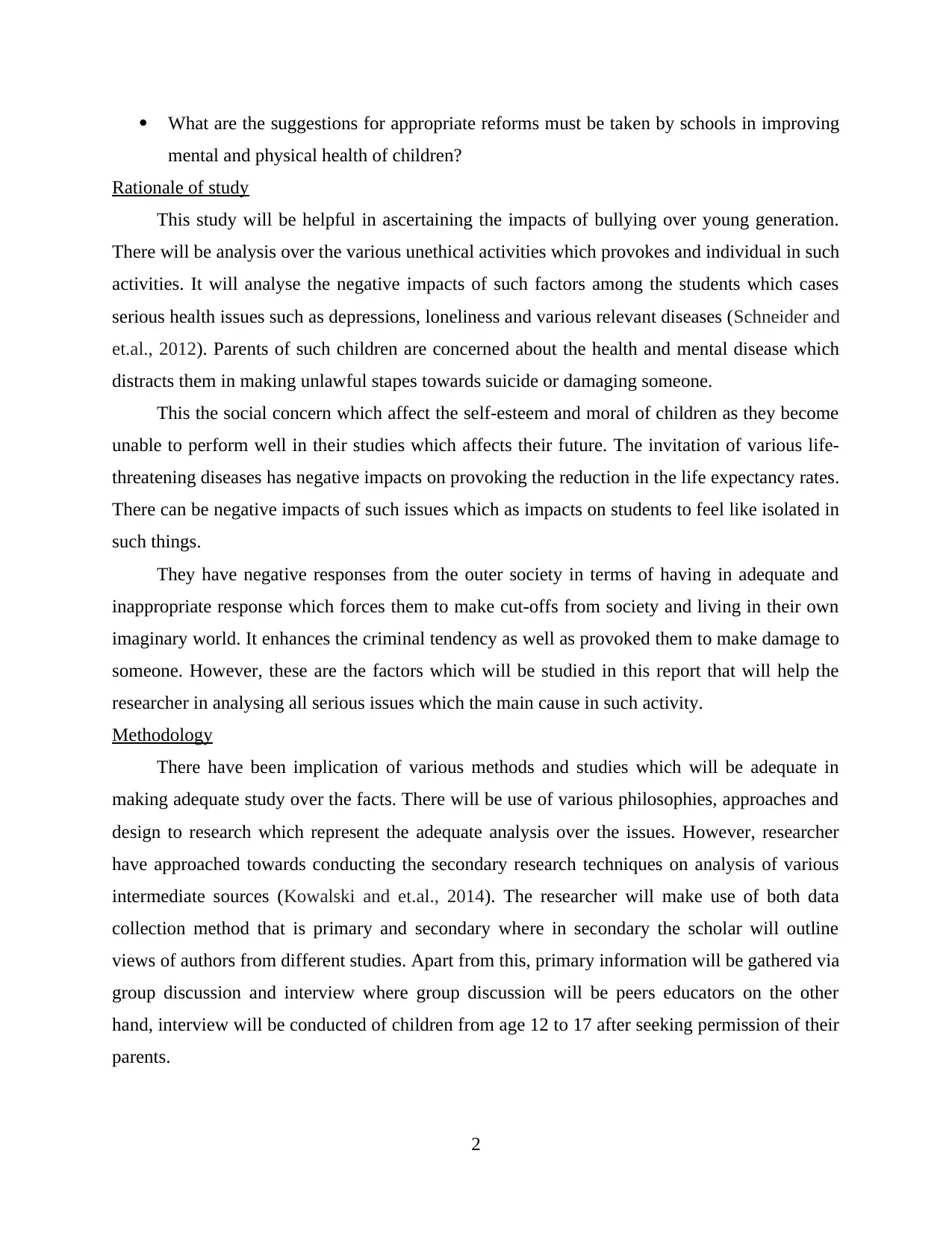
What are the suggestions for appropriate reforms must be taken by schools in improving
mental and physical health of children?
Rationale of study
This study will be helpful in ascertaining the impacts of bullying over young generation.
There will be analysis over the various unethical activities which provokes and individual in such
activities. It will analyse the negative impacts of such factors among the students which cases
serious health issues such as depressions, loneliness and various relevant diseases (Schneider and
et.al., 2012). Parents of such children are concerned about the health and mental disease which
distracts them in making unlawful stapes towards suicide or damaging someone.
This the social concern which affect the self-esteem and moral of children as they become
unable to perform well in their studies which affects their future. The invitation of various life-
threatening diseases has negative impacts on provoking the reduction in the life expectancy rates.
There can be negative impacts of such issues which as impacts on students to feel like isolated in
such things.
They have negative responses from the outer society in terms of having in adequate and
inappropriate response which forces them to make cut-offs from society and living in their own
imaginary world. It enhances the criminal tendency as well as provoked them to make damage to
someone. However, these are the factors which will be studied in this report that will help the
researcher in analysing all serious issues which the main cause in such activity.
Methodology
There have been implication of various methods and studies which will be adequate in
making adequate study over the facts. There will be use of various philosophies, approaches and
design to research which represent the adequate analysis over the issues. However, researcher
have approached towards conducting the secondary research techniques on analysis of various
intermediate sources (Kowalski and et.al., 2014). The researcher will make use of both data
collection method that is primary and secondary where in secondary the scholar will outline
views of authors from different studies. Apart from this, primary information will be gathered via
group discussion and interview where group discussion will be peers educators on the other
hand, interview will be conducted of children from age 12 to 17 after seeking permission of their
parents.
2
mental and physical health of children?
Rationale of study
This study will be helpful in ascertaining the impacts of bullying over young generation.
There will be analysis over the various unethical activities which provokes and individual in such
activities. It will analyse the negative impacts of such factors among the students which cases
serious health issues such as depressions, loneliness and various relevant diseases (Schneider and
et.al., 2012). Parents of such children are concerned about the health and mental disease which
distracts them in making unlawful stapes towards suicide or damaging someone.
This the social concern which affect the self-esteem and moral of children as they become
unable to perform well in their studies which affects their future. The invitation of various life-
threatening diseases has negative impacts on provoking the reduction in the life expectancy rates.
There can be negative impacts of such issues which as impacts on students to feel like isolated in
such things.
They have negative responses from the outer society in terms of having in adequate and
inappropriate response which forces them to make cut-offs from society and living in their own
imaginary world. It enhances the criminal tendency as well as provoked them to make damage to
someone. However, these are the factors which will be studied in this report that will help the
researcher in analysing all serious issues which the main cause in such activity.
Methodology
There have been implication of various methods and studies which will be adequate in
making adequate study over the facts. There will be use of various philosophies, approaches and
design to research which represent the adequate analysis over the issues. However, researcher
have approached towards conducting the secondary research techniques on analysis of various
intermediate sources (Kowalski and et.al., 2014). The researcher will make use of both data
collection method that is primary and secondary where in secondary the scholar will outline
views of authors from different studies. Apart from this, primary information will be gathered via
group discussion and interview where group discussion will be peers educators on the other
hand, interview will be conducted of children from age 12 to 17 after seeking permission of their
parents.
2
Paraphrase This Document
Need a fresh take? Get an instant paraphrase of this document with our AI Paraphraser
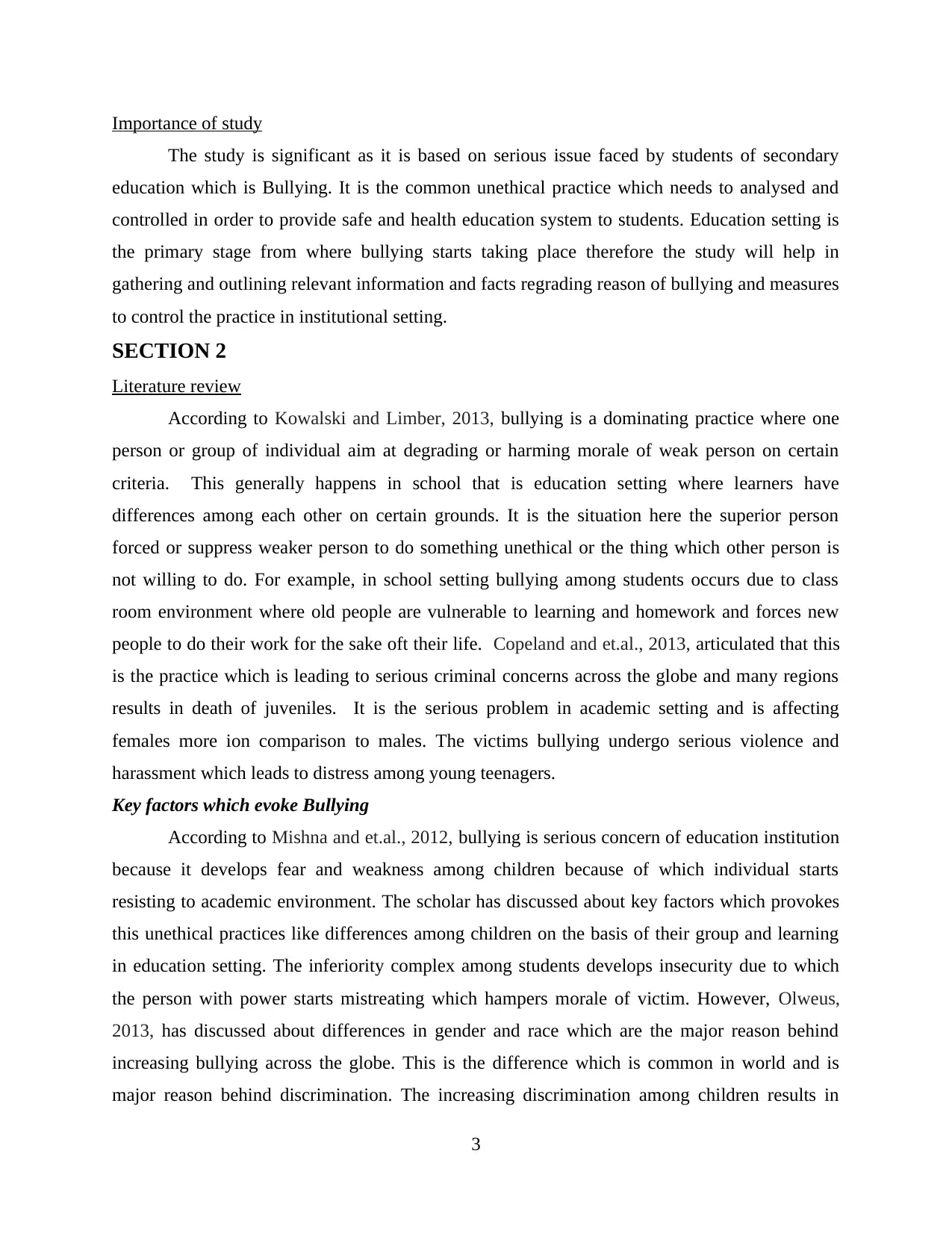
Importance of study
The study is significant as it is based on serious issue faced by students of secondary
education which is Bullying. It is the common unethical practice which needs to analysed and
controlled in order to provide safe and health education system to students. Education setting is
the primary stage from where bullying starts taking place therefore the study will help in
gathering and outlining relevant information and facts regrading reason of bullying and measures
to control the practice in institutional setting.
SECTION 2
Literature review
According to Kowalski and Limber, 2013, bullying is a dominating practice where one
person or group of individual aim at degrading or harming morale of weak person on certain
criteria. This generally happens in school that is education setting where learners have
differences among each other on certain grounds. It is the situation here the superior person
forced or suppress weaker person to do something unethical or the thing which other person is
not willing to do. For example, in school setting bullying among students occurs due to class
room environment where old people are vulnerable to learning and homework and forces new
people to do their work for the sake oft their life. Copeland and et.al., 2013, articulated that this
is the practice which is leading to serious criminal concerns across the globe and many regions
results in death of juveniles. It is the serious problem in academic setting and is affecting
females more ion comparison to males. The victims bullying undergo serious violence and
harassment which leads to distress among young teenagers.
Key factors which evoke Bullying
According to Mishna and et.al., 2012, bullying is serious concern of education institution
because it develops fear and weakness among children because of which individual starts
resisting to academic environment. The scholar has discussed about key factors which provokes
this unethical practices like differences among children on the basis of their group and learning
in education setting. The inferiority complex among students develops insecurity due to which
the person with power starts mistreating which hampers morale of victim. However, Olweus,
2013, has discussed about differences in gender and race which are the major reason behind
increasing bullying across the globe. This is the difference which is common in world and is
major reason behind discrimination. The increasing discrimination among children results in
3
The study is significant as it is based on serious issue faced by students of secondary
education which is Bullying. It is the common unethical practice which needs to analysed and
controlled in order to provide safe and health education system to students. Education setting is
the primary stage from where bullying starts taking place therefore the study will help in
gathering and outlining relevant information and facts regrading reason of bullying and measures
to control the practice in institutional setting.
SECTION 2
Literature review
According to Kowalski and Limber, 2013, bullying is a dominating practice where one
person or group of individual aim at degrading or harming morale of weak person on certain
criteria. This generally happens in school that is education setting where learners have
differences among each other on certain grounds. It is the situation here the superior person
forced or suppress weaker person to do something unethical or the thing which other person is
not willing to do. For example, in school setting bullying among students occurs due to class
room environment where old people are vulnerable to learning and homework and forces new
people to do their work for the sake oft their life. Copeland and et.al., 2013, articulated that this
is the practice which is leading to serious criminal concerns across the globe and many regions
results in death of juveniles. It is the serious problem in academic setting and is affecting
females more ion comparison to males. The victims bullying undergo serious violence and
harassment which leads to distress among young teenagers.
Key factors which evoke Bullying
According to Mishna and et.al., 2012, bullying is serious concern of education institution
because it develops fear and weakness among children because of which individual starts
resisting to academic environment. The scholar has discussed about key factors which provokes
this unethical practices like differences among children on the basis of their group and learning
in education setting. The inferiority complex among students develops insecurity due to which
the person with power starts mistreating which hampers morale of victim. However, Olweus,
2013, has discussed about differences in gender and race which are the major reason behind
increasing bullying across the globe. This is the difference which is common in world and is
major reason behind discrimination. The increasing discrimination among children results in
3
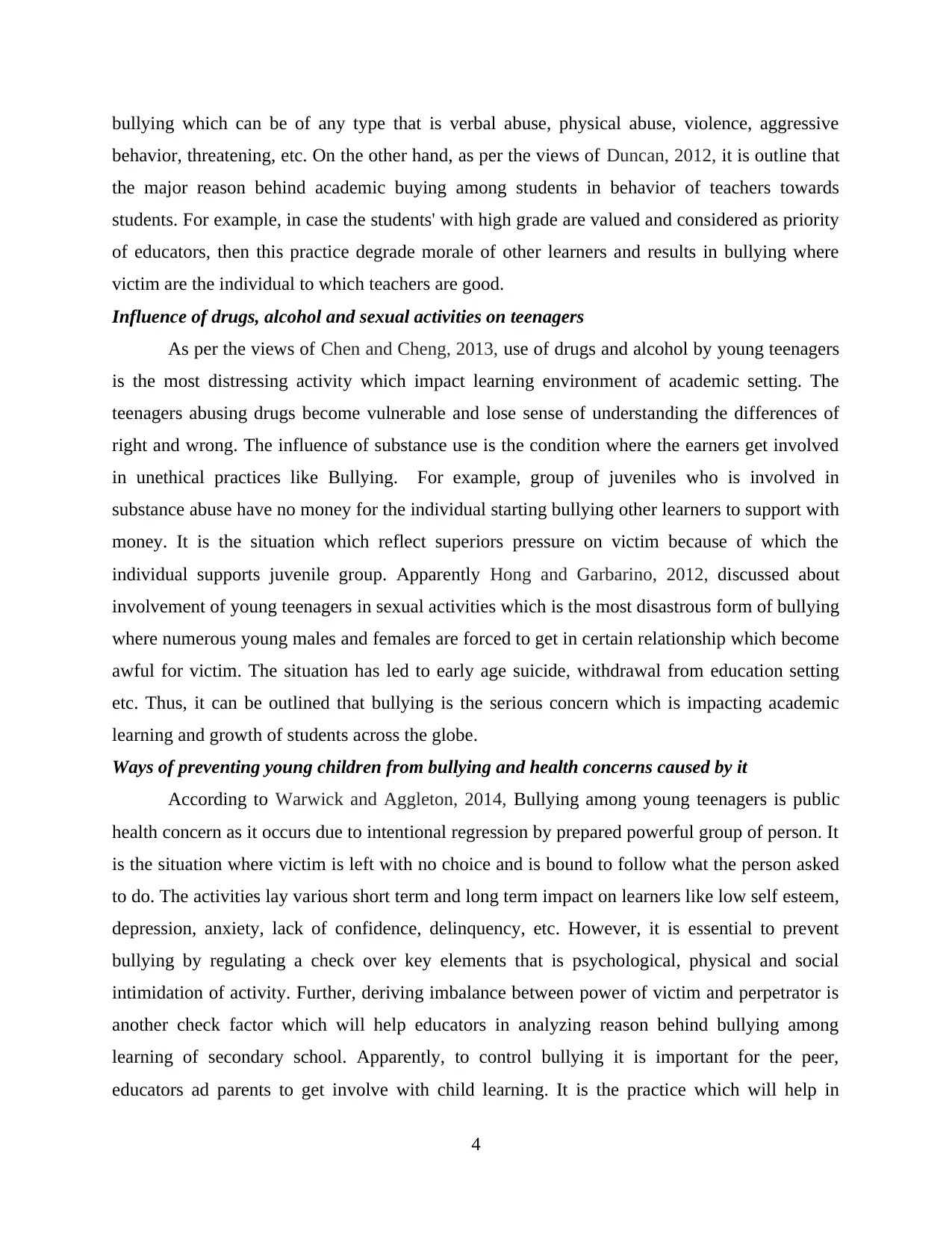
bullying which can be of any type that is verbal abuse, physical abuse, violence, aggressive
behavior, threatening, etc. On the other hand, as per the views of Duncan, 2012, it is outline that
the major reason behind academic buying among students in behavior of teachers towards
students. For example, in case the students' with high grade are valued and considered as priority
of educators, then this practice degrade morale of other learners and results in bullying where
victim are the individual to which teachers are good.
Influence of drugs, alcohol and sexual activities on teenagers
As per the views of Chen and Cheng, 2013, use of drugs and alcohol by young teenagers
is the most distressing activity which impact learning environment of academic setting. The
teenagers abusing drugs become vulnerable and lose sense of understanding the differences of
right and wrong. The influence of substance use is the condition where the earners get involved
in unethical practices like Bullying. For example, group of juveniles who is involved in
substance abuse have no money for the individual starting bullying other learners to support with
money. It is the situation which reflect superiors pressure on victim because of which the
individual supports juvenile group. Apparently Hong and Garbarino, 2012, discussed about
involvement of young teenagers in sexual activities which is the most disastrous form of bullying
where numerous young males and females are forced to get in certain relationship which become
awful for victim. The situation has led to early age suicide, withdrawal from education setting
etc. Thus, it can be outlined that bullying is the serious concern which is impacting academic
learning and growth of students across the globe.
Ways of preventing young children from bullying and health concerns caused by it
According to Warwick and Aggleton, 2014, Bullying among young teenagers is public
health concern as it occurs due to intentional regression by prepared powerful group of person. It
is the situation where victim is left with no choice and is bound to follow what the person asked
to do. The activities lay various short term and long term impact on learners like low self esteem,
depression, anxiety, lack of confidence, delinquency, etc. However, it is essential to prevent
bullying by regulating a check over key elements that is psychological, physical and social
intimidation of activity. Further, deriving imbalance between power of victim and perpetrator is
another check factor which will help educators in analyzing reason behind bullying among
learning of secondary school. Apparently, to control bullying it is important for the peer,
educators ad parents to get involve with child learning. It is the practice which will help in
4
behavior, threatening, etc. On the other hand, as per the views of Duncan, 2012, it is outline that
the major reason behind academic buying among students in behavior of teachers towards
students. For example, in case the students' with high grade are valued and considered as priority
of educators, then this practice degrade morale of other learners and results in bullying where
victim are the individual to which teachers are good.
Influence of drugs, alcohol and sexual activities on teenagers
As per the views of Chen and Cheng, 2013, use of drugs and alcohol by young teenagers
is the most distressing activity which impact learning environment of academic setting. The
teenagers abusing drugs become vulnerable and lose sense of understanding the differences of
right and wrong. The influence of substance use is the condition where the earners get involved
in unethical practices like Bullying. For example, group of juveniles who is involved in
substance abuse have no money for the individual starting bullying other learners to support with
money. It is the situation which reflect superiors pressure on victim because of which the
individual supports juvenile group. Apparently Hong and Garbarino, 2012, discussed about
involvement of young teenagers in sexual activities which is the most disastrous form of bullying
where numerous young males and females are forced to get in certain relationship which become
awful for victim. The situation has led to early age suicide, withdrawal from education setting
etc. Thus, it can be outlined that bullying is the serious concern which is impacting academic
learning and growth of students across the globe.
Ways of preventing young children from bullying and health concerns caused by it
According to Warwick and Aggleton, 2014, Bullying among young teenagers is public
health concern as it occurs due to intentional regression by prepared powerful group of person. It
is the situation where victim is left with no choice and is bound to follow what the person asked
to do. The activities lay various short term and long term impact on learners like low self esteem,
depression, anxiety, lack of confidence, delinquency, etc. However, it is essential to prevent
bullying by regulating a check over key elements that is psychological, physical and social
intimidation of activity. Further, deriving imbalance between power of victim and perpetrator is
another check factor which will help educators in analyzing reason behind bullying among
learning of secondary school. Apparently, to control bullying it is important for the peer,
educators ad parents to get involve with child learning. It is the practice which will help in
4
⊘ This is a preview!⊘
Do you want full access?
Subscribe today to unlock all pages.

Trusted by 1+ million students worldwide
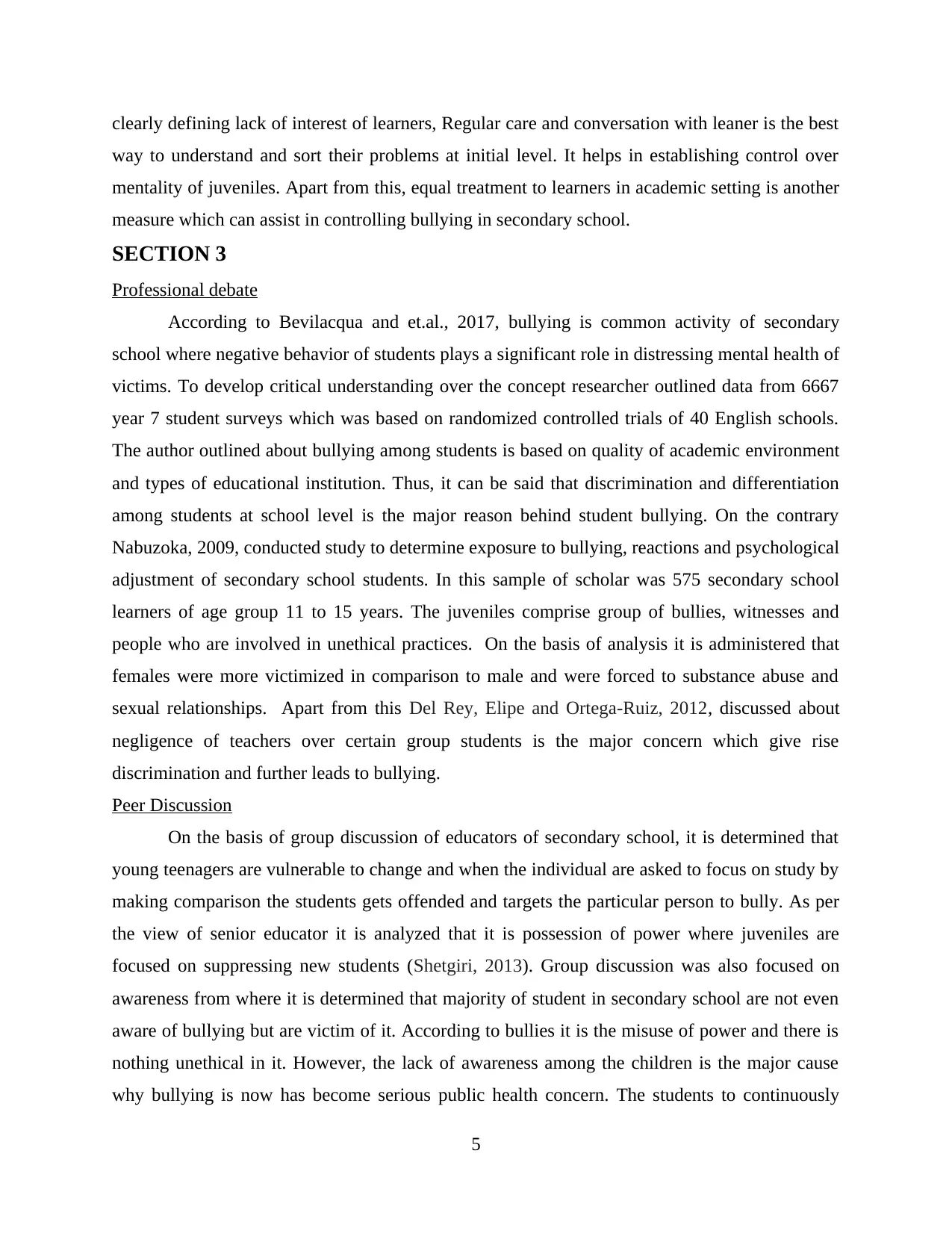
clearly defining lack of interest of learners, Regular care and conversation with leaner is the best
way to understand and sort their problems at initial level. It helps in establishing control over
mentality of juveniles. Apart from this, equal treatment to learners in academic setting is another
measure which can assist in controlling bullying in secondary school.
SECTION 3
Professional debate
According to Bevilacqua and et.al., 2017, bullying is common activity of secondary
school where negative behavior of students plays a significant role in distressing mental health of
victims. To develop critical understanding over the concept researcher outlined data from 6667
year 7 student surveys which was based on randomized controlled trials of 40 English schools.
The author outlined about bullying among students is based on quality of academic environment
and types of educational institution. Thus, it can be said that discrimination and differentiation
among students at school level is the major reason behind student bullying. On the contrary
Nabuzoka, 2009, conducted study to determine exposure to bullying, reactions and psychological
adjustment of secondary school students. In this sample of scholar was 575 secondary school
learners of age group 11 to 15 years. The juveniles comprise group of bullies, witnesses and
people who are involved in unethical practices. On the basis of analysis it is administered that
females were more victimized in comparison to male and were forced to substance abuse and
sexual relationships. Apart from this Del Rey, Elipe and Ortega-Ruiz, 2012, discussed about
negligence of teachers over certain group students is the major concern which give rise
discrimination and further leads to bullying.
Peer Discussion
On the basis of group discussion of educators of secondary school, it is determined that
young teenagers are vulnerable to change and when the individual are asked to focus on study by
making comparison the students gets offended and targets the particular person to bully. As per
the view of senior educator it is analyzed that it is possession of power where juveniles are
focused on suppressing new students (Shetgiri, 2013). Group discussion was also focused on
awareness from where it is determined that majority of student in secondary school are not even
aware of bullying but are victim of it. According to bullies it is the misuse of power and there is
nothing unethical in it. However, the lack of awareness among the children is the major cause
why bullying is now has become serious public health concern. The students to continuously
5
way to understand and sort their problems at initial level. It helps in establishing control over
mentality of juveniles. Apart from this, equal treatment to learners in academic setting is another
measure which can assist in controlling bullying in secondary school.
SECTION 3
Professional debate
According to Bevilacqua and et.al., 2017, bullying is common activity of secondary
school where negative behavior of students plays a significant role in distressing mental health of
victims. To develop critical understanding over the concept researcher outlined data from 6667
year 7 student surveys which was based on randomized controlled trials of 40 English schools.
The author outlined about bullying among students is based on quality of academic environment
and types of educational institution. Thus, it can be said that discrimination and differentiation
among students at school level is the major reason behind student bullying. On the contrary
Nabuzoka, 2009, conducted study to determine exposure to bullying, reactions and psychological
adjustment of secondary school students. In this sample of scholar was 575 secondary school
learners of age group 11 to 15 years. The juveniles comprise group of bullies, witnesses and
people who are involved in unethical practices. On the basis of analysis it is administered that
females were more victimized in comparison to male and were forced to substance abuse and
sexual relationships. Apart from this Del Rey, Elipe and Ortega-Ruiz, 2012, discussed about
negligence of teachers over certain group students is the major concern which give rise
discrimination and further leads to bullying.
Peer Discussion
On the basis of group discussion of educators of secondary school, it is determined that
young teenagers are vulnerable to change and when the individual are asked to focus on study by
making comparison the students gets offended and targets the particular person to bully. As per
the view of senior educator it is analyzed that it is possession of power where juveniles are
focused on suppressing new students (Shetgiri, 2013). Group discussion was also focused on
awareness from where it is determined that majority of student in secondary school are not even
aware of bullying but are victim of it. According to bullies it is the misuse of power and there is
nothing unethical in it. However, the lack of awareness among the children is the major cause
why bullying is now has become serious public health concern. The students to continuously
5
Paraphrase This Document
Need a fresh take? Get an instant paraphrase of this document with our AI Paraphraser
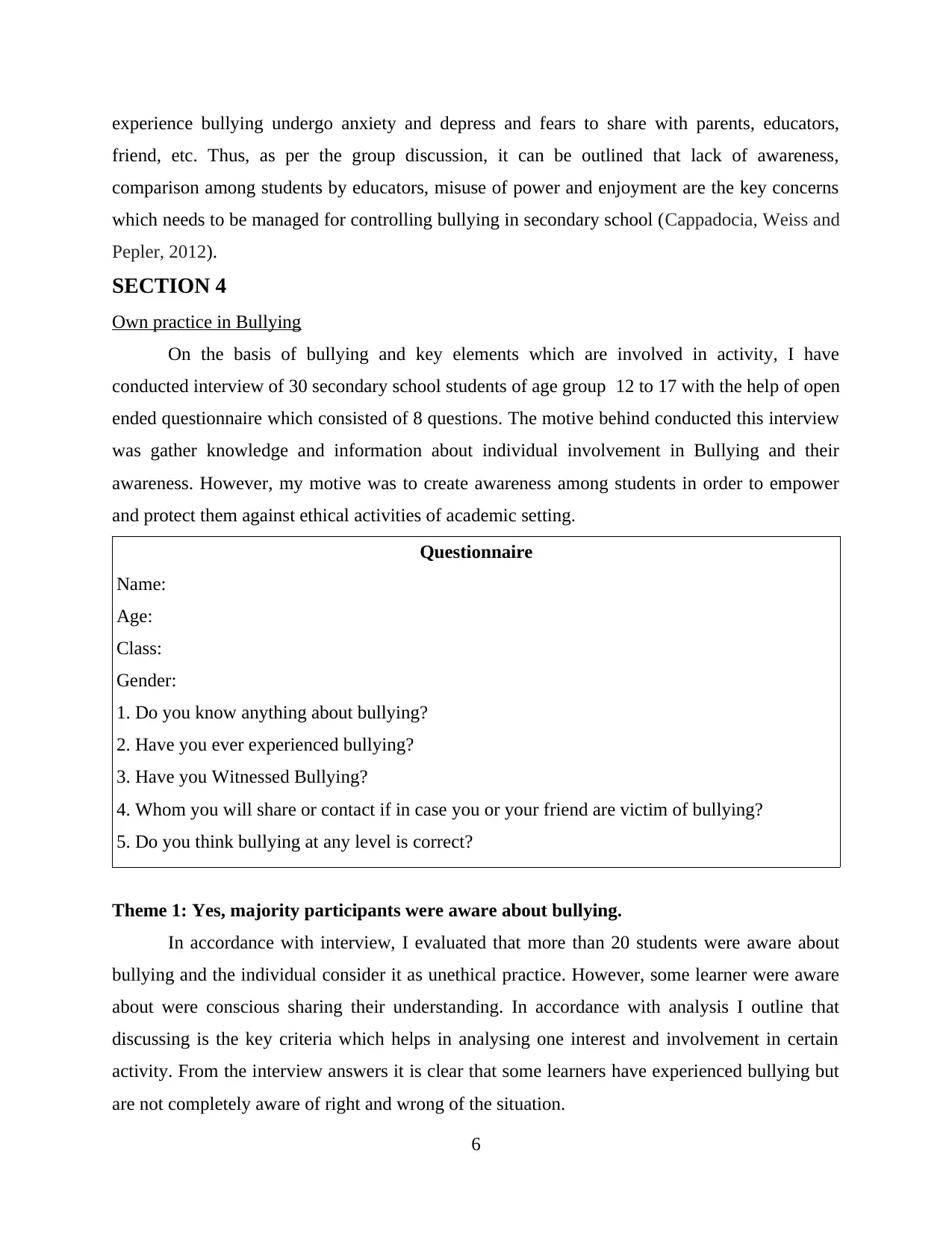
experience bullying undergo anxiety and depress and fears to share with parents, educators,
friend, etc. Thus, as per the group discussion, it can be outlined that lack of awareness,
comparison among students by educators, misuse of power and enjoyment are the key concerns
which needs to be managed for controlling bullying in secondary school (Cappadocia, Weiss and
Pepler, 2012).
SECTION 4
Own practice in Bullying
On the basis of bullying and key elements which are involved in activity, I have
conducted interview of 30 secondary school students of age group 12 to 17 with the help of open
ended questionnaire which consisted of 8 questions. The motive behind conducted this interview
was gather knowledge and information about individual involvement in Bullying and their
awareness. However, my motive was to create awareness among students in order to empower
and protect them against ethical activities of academic setting.
Questionnaire
Name:
Age:
Class:
Gender:
1. Do you know anything about bullying?
2. Have you ever experienced bullying?
3. Have you Witnessed Bullying?
4. Whom you will share or contact if in case you or your friend are victim of bullying?
5. Do you think bullying at any level is correct?
Theme 1: Yes, majority participants were aware about bullying.
In accordance with interview, I evaluated that more than 20 students were aware about
bullying and the individual consider it as unethical practice. However, some learner were aware
about were conscious sharing their understanding. In accordance with analysis I outline that
discussing is the key criteria which helps in analysing one interest and involvement in certain
activity. From the interview answers it is clear that some learners have experienced bullying but
are not completely aware of right and wrong of the situation.
6
friend, etc. Thus, as per the group discussion, it can be outlined that lack of awareness,
comparison among students by educators, misuse of power and enjoyment are the key concerns
which needs to be managed for controlling bullying in secondary school (Cappadocia, Weiss and
Pepler, 2012).
SECTION 4
Own practice in Bullying
On the basis of bullying and key elements which are involved in activity, I have
conducted interview of 30 secondary school students of age group 12 to 17 with the help of open
ended questionnaire which consisted of 8 questions. The motive behind conducted this interview
was gather knowledge and information about individual involvement in Bullying and their
awareness. However, my motive was to create awareness among students in order to empower
and protect them against ethical activities of academic setting.
Questionnaire
Name:
Age:
Class:
Gender:
1. Do you know anything about bullying?
2. Have you ever experienced bullying?
3. Have you Witnessed Bullying?
4. Whom you will share or contact if in case you or your friend are victim of bullying?
5. Do you think bullying at any level is correct?
Theme 1: Yes, majority participants were aware about bullying.
In accordance with interview, I evaluated that more than 20 students were aware about
bullying and the individual consider it as unethical practice. However, some learner were aware
about were conscious sharing their understanding. In accordance with analysis I outline that
discussing is the key criteria which helps in analysing one interest and involvement in certain
activity. From the interview answers it is clear that some learners have experienced bullying but
are not completely aware of right and wrong of the situation.
6
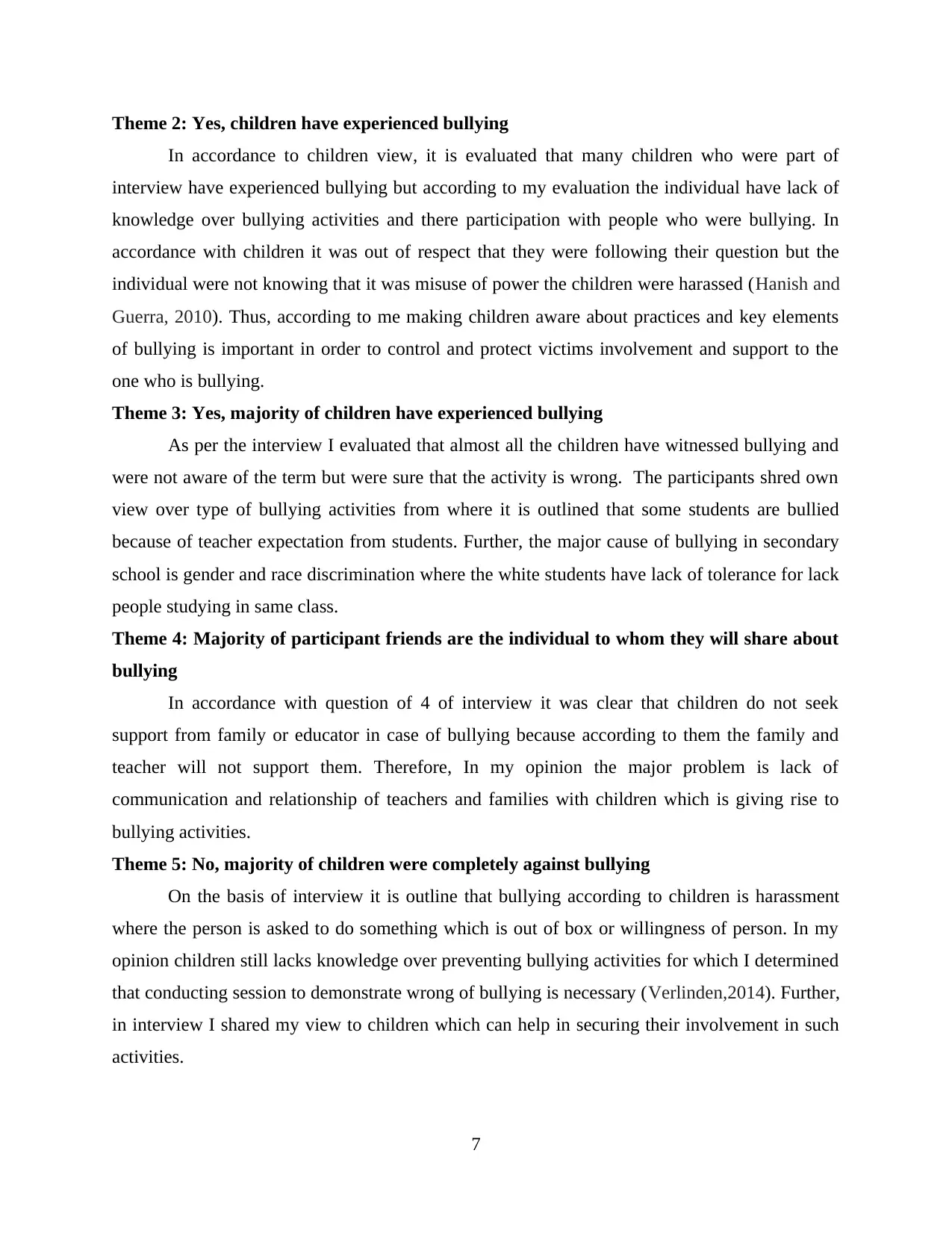
Theme 2: Yes, children have experienced bullying
In accordance to children view, it is evaluated that many children who were part of
interview have experienced bullying but according to my evaluation the individual have lack of
knowledge over bullying activities and there participation with people who were bullying. In
accordance with children it was out of respect that they were following their question but the
individual were not knowing that it was misuse of power the children were harassed (Hanish and
Guerra, 2010). Thus, according to me making children aware about practices and key elements
of bullying is important in order to control and protect victims involvement and support to the
one who is bullying.
Theme 3: Yes, majority of children have experienced bullying
As per the interview I evaluated that almost all the children have witnessed bullying and
were not aware of the term but were sure that the activity is wrong. The participants shred own
view over type of bullying activities from where it is outlined that some students are bullied
because of teacher expectation from students. Further, the major cause of bullying in secondary
school is gender and race discrimination where the white students have lack of tolerance for lack
people studying in same class.
Theme 4: Majority of participant friends are the individual to whom they will share about
bullying
In accordance with question of 4 of interview it was clear that children do not seek
support from family or educator in case of bullying because according to them the family and
teacher will not support them. Therefore, In my opinion the major problem is lack of
communication and relationship of teachers and families with children which is giving rise to
bullying activities.
Theme 5: No, majority of children were completely against bullying
On the basis of interview it is outline that bullying according to children is harassment
where the person is asked to do something which is out of box or willingness of person. In my
opinion children still lacks knowledge over preventing bullying activities for which I determined
that conducting session to demonstrate wrong of bullying is necessary (Verlinden,2014). Further,
in interview I shared my view to children which can help in securing their involvement in such
activities.
7
In accordance to children view, it is evaluated that many children who were part of
interview have experienced bullying but according to my evaluation the individual have lack of
knowledge over bullying activities and there participation with people who were bullying. In
accordance with children it was out of respect that they were following their question but the
individual were not knowing that it was misuse of power the children were harassed (Hanish and
Guerra, 2010). Thus, according to me making children aware about practices and key elements
of bullying is important in order to control and protect victims involvement and support to the
one who is bullying.
Theme 3: Yes, majority of children have experienced bullying
As per the interview I evaluated that almost all the children have witnessed bullying and
were not aware of the term but were sure that the activity is wrong. The participants shred own
view over type of bullying activities from where it is outlined that some students are bullied
because of teacher expectation from students. Further, the major cause of bullying in secondary
school is gender and race discrimination where the white students have lack of tolerance for lack
people studying in same class.
Theme 4: Majority of participant friends are the individual to whom they will share about
bullying
In accordance with question of 4 of interview it was clear that children do not seek
support from family or educator in case of bullying because according to them the family and
teacher will not support them. Therefore, In my opinion the major problem is lack of
communication and relationship of teachers and families with children which is giving rise to
bullying activities.
Theme 5: No, majority of children were completely against bullying
On the basis of interview it is outline that bullying according to children is harassment
where the person is asked to do something which is out of box or willingness of person. In my
opinion children still lacks knowledge over preventing bullying activities for which I determined
that conducting session to demonstrate wrong of bullying is necessary (Verlinden,2014). Further,
in interview I shared my view to children which can help in securing their involvement in such
activities.
7
⊘ This is a preview!⊘
Do you want full access?
Subscribe today to unlock all pages.

Trusted by 1+ million students worldwide
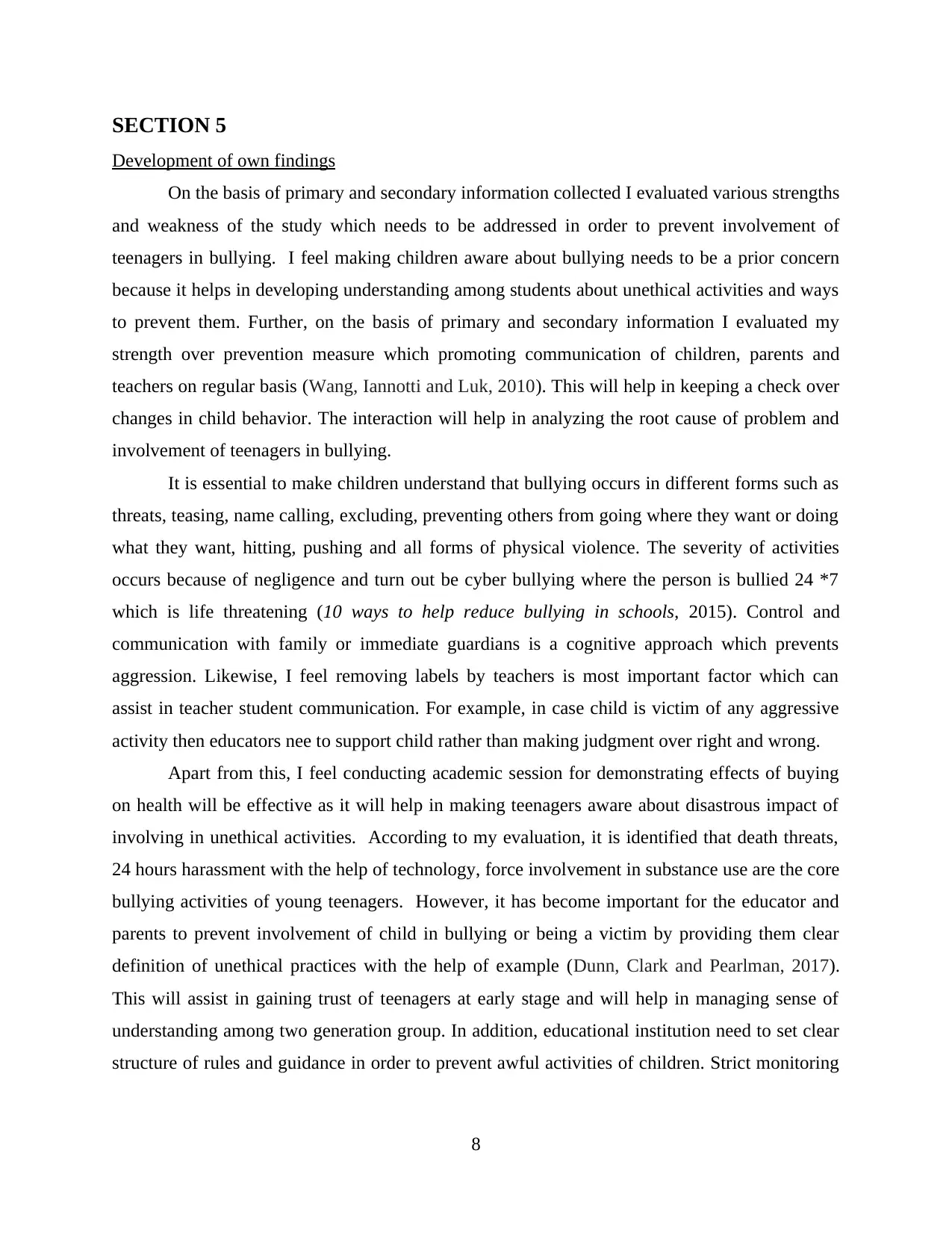
SECTION 5
Development of own findings
On the basis of primary and secondary information collected I evaluated various strengths
and weakness of the study which needs to be addressed in order to prevent involvement of
teenagers in bullying. I feel making children aware about bullying needs to be a prior concern
because it helps in developing understanding among students about unethical activities and ways
to prevent them. Further, on the basis of primary and secondary information I evaluated my
strength over prevention measure which promoting communication of children, parents and
teachers on regular basis (Wang, Iannotti and Luk, 2010). This will help in keeping a check over
changes in child behavior. The interaction will help in analyzing the root cause of problem and
involvement of teenagers in bullying.
It is essential to make children understand that bullying occurs in different forms such as
threats, teasing, name calling, excluding, preventing others from going where they want or doing
what they want, hitting, pushing and all forms of physical violence. The severity of activities
occurs because of negligence and turn out be cyber bullying where the person is bullied 24 *7
which is life threatening (10 ways to help reduce bullying in schools, 2015). Control and
communication with family or immediate guardians is a cognitive approach which prevents
aggression. Likewise, I feel removing labels by teachers is most important factor which can
assist in teacher student communication. For example, in case child is victim of any aggressive
activity then educators nee to support child rather than making judgment over right and wrong.
Apart from this, I feel conducting academic session for demonstrating effects of buying
on health will be effective as it will help in making teenagers aware about disastrous impact of
involving in unethical activities. According to my evaluation, it is identified that death threats,
24 hours harassment with the help of technology, force involvement in substance use are the core
bullying activities of young teenagers. However, it has become important for the educator and
parents to prevent involvement of child in bullying or being a victim by providing them clear
definition of unethical practices with the help of example (Dunn, Clark and Pearlman, 2017).
This will assist in gaining trust of teenagers at early stage and will help in managing sense of
understanding among two generation group. In addition, educational institution need to set clear
structure of rules and guidance in order to prevent awful activities of children. Strict monitoring
8
Development of own findings
On the basis of primary and secondary information collected I evaluated various strengths
and weakness of the study which needs to be addressed in order to prevent involvement of
teenagers in bullying. I feel making children aware about bullying needs to be a prior concern
because it helps in developing understanding among students about unethical activities and ways
to prevent them. Further, on the basis of primary and secondary information I evaluated my
strength over prevention measure which promoting communication of children, parents and
teachers on regular basis (Wang, Iannotti and Luk, 2010). This will help in keeping a check over
changes in child behavior. The interaction will help in analyzing the root cause of problem and
involvement of teenagers in bullying.
It is essential to make children understand that bullying occurs in different forms such as
threats, teasing, name calling, excluding, preventing others from going where they want or doing
what they want, hitting, pushing and all forms of physical violence. The severity of activities
occurs because of negligence and turn out be cyber bullying where the person is bullied 24 *7
which is life threatening (10 ways to help reduce bullying in schools, 2015). Control and
communication with family or immediate guardians is a cognitive approach which prevents
aggression. Likewise, I feel removing labels by teachers is most important factor which can
assist in teacher student communication. For example, in case child is victim of any aggressive
activity then educators nee to support child rather than making judgment over right and wrong.
Apart from this, I feel conducting academic session for demonstrating effects of buying
on health will be effective as it will help in making teenagers aware about disastrous impact of
involving in unethical activities. According to my evaluation, it is identified that death threats,
24 hours harassment with the help of technology, force involvement in substance use are the core
bullying activities of young teenagers. However, it has become important for the educator and
parents to prevent involvement of child in bullying or being a victim by providing them clear
definition of unethical practices with the help of example (Dunn, Clark and Pearlman, 2017).
This will assist in gaining trust of teenagers at early stage and will help in managing sense of
understanding among two generation group. In addition, educational institution need to set clear
structure of rules and guidance in order to prevent awful activities of children. Strict monitoring
8
Paraphrase This Document
Need a fresh take? Get an instant paraphrase of this document with our AI Paraphraser
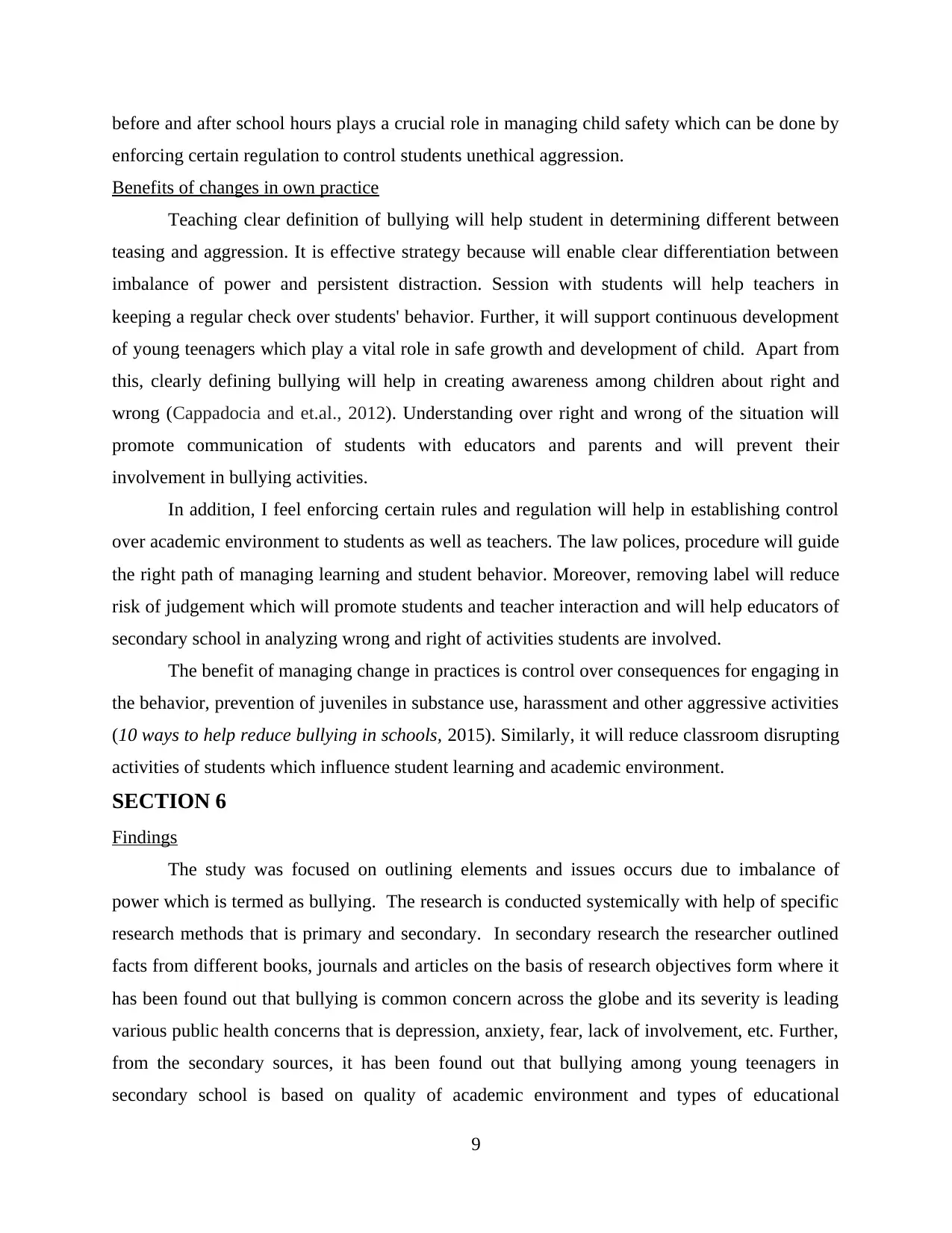
before and after school hours plays a crucial role in managing child safety which can be done by
enforcing certain regulation to control students unethical aggression.
Benefits of changes in own practice
Teaching clear definition of bullying will help student in determining different between
teasing and aggression. It is effective strategy because will enable clear differentiation between
imbalance of power and persistent distraction. Session with students will help teachers in
keeping a regular check over students' behavior. Further, it will support continuous development
of young teenagers which play a vital role in safe growth and development of child. Apart from
this, clearly defining bullying will help in creating awareness among children about right and
wrong (Cappadocia and et.al., 2012). Understanding over right and wrong of the situation will
promote communication of students with educators and parents and will prevent their
involvement in bullying activities.
In addition, I feel enforcing certain rules and regulation will help in establishing control
over academic environment to students as well as teachers. The law polices, procedure will guide
the right path of managing learning and student behavior. Moreover, removing label will reduce
risk of judgement which will promote students and teacher interaction and will help educators of
secondary school in analyzing wrong and right of activities students are involved.
The benefit of managing change in practices is control over consequences for engaging in
the behavior, prevention of juveniles in substance use, harassment and other aggressive activities
(10 ways to help reduce bullying in schools, 2015). Similarly, it will reduce classroom disrupting
activities of students which influence student learning and academic environment.
SECTION 6
Findings
The study was focused on outlining elements and issues occurs due to imbalance of
power which is termed as bullying. The research is conducted systemically with help of specific
research methods that is primary and secondary. In secondary research the researcher outlined
facts from different books, journals and articles on the basis of research objectives form where it
has been found out that bullying is common concern across the globe and its severity is leading
various public health concerns that is depression, anxiety, fear, lack of involvement, etc. Further,
from the secondary sources, it has been found out that bullying among young teenagers in
secondary school is based on quality of academic environment and types of educational
9
enforcing certain regulation to control students unethical aggression.
Benefits of changes in own practice
Teaching clear definition of bullying will help student in determining different between
teasing and aggression. It is effective strategy because will enable clear differentiation between
imbalance of power and persistent distraction. Session with students will help teachers in
keeping a regular check over students' behavior. Further, it will support continuous development
of young teenagers which play a vital role in safe growth and development of child. Apart from
this, clearly defining bullying will help in creating awareness among children about right and
wrong (Cappadocia and et.al., 2012). Understanding over right and wrong of the situation will
promote communication of students with educators and parents and will prevent their
involvement in bullying activities.
In addition, I feel enforcing certain rules and regulation will help in establishing control
over academic environment to students as well as teachers. The law polices, procedure will guide
the right path of managing learning and student behavior. Moreover, removing label will reduce
risk of judgement which will promote students and teacher interaction and will help educators of
secondary school in analyzing wrong and right of activities students are involved.
The benefit of managing change in practices is control over consequences for engaging in
the behavior, prevention of juveniles in substance use, harassment and other aggressive activities
(10 ways to help reduce bullying in schools, 2015). Similarly, it will reduce classroom disrupting
activities of students which influence student learning and academic environment.
SECTION 6
Findings
The study was focused on outlining elements and issues occurs due to imbalance of
power which is termed as bullying. The research is conducted systemically with help of specific
research methods that is primary and secondary. In secondary research the researcher outlined
facts from different books, journals and articles on the basis of research objectives form where it
has been found out that bullying is common concern across the globe and its severity is leading
various public health concerns that is depression, anxiety, fear, lack of involvement, etc. Further,
from the secondary sources, it has been found out that bullying among young teenagers in
secondary school is based on quality of academic environment and types of educational
9
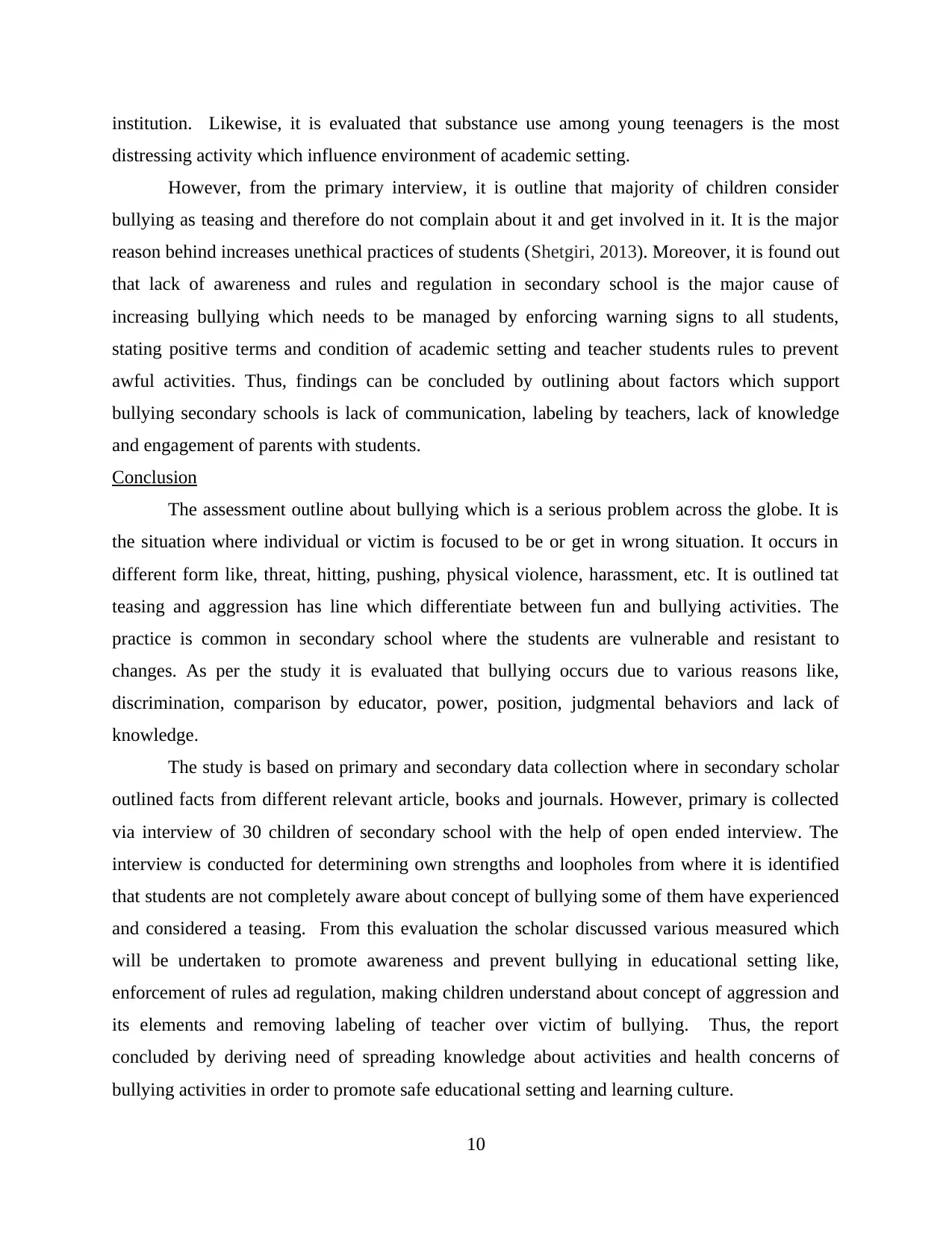
institution. Likewise, it is evaluated that substance use among young teenagers is the most
distressing activity which influence environment of academic setting.
However, from the primary interview, it is outline that majority of children consider
bullying as teasing and therefore do not complain about it and get involved in it. It is the major
reason behind increases unethical practices of students (Shetgiri, 2013). Moreover, it is found out
that lack of awareness and rules and regulation in secondary school is the major cause of
increasing bullying which needs to be managed by enforcing warning signs to all students,
stating positive terms and condition of academic setting and teacher students rules to prevent
awful activities. Thus, findings can be concluded by outlining about factors which support
bullying secondary schools is lack of communication, labeling by teachers, lack of knowledge
and engagement of parents with students.
Conclusion
The assessment outline about bullying which is a serious problem across the globe. It is
the situation where individual or victim is focused to be or get in wrong situation. It occurs in
different form like, threat, hitting, pushing, physical violence, harassment, etc. It is outlined tat
teasing and aggression has line which differentiate between fun and bullying activities. The
practice is common in secondary school where the students are vulnerable and resistant to
changes. As per the study it is evaluated that bullying occurs due to various reasons like,
discrimination, comparison by educator, power, position, judgmental behaviors and lack of
knowledge.
The study is based on primary and secondary data collection where in secondary scholar
outlined facts from different relevant article, books and journals. However, primary is collected
via interview of 30 children of secondary school with the help of open ended interview. The
interview is conducted for determining own strengths and loopholes from where it is identified
that students are not completely aware about concept of bullying some of them have experienced
and considered a teasing. From this evaluation the scholar discussed various measured which
will be undertaken to promote awareness and prevent bullying in educational setting like,
enforcement of rules ad regulation, making children understand about concept of aggression and
its elements and removing labeling of teacher over victim of bullying. Thus, the report
concluded by deriving need of spreading knowledge about activities and health concerns of
bullying activities in order to promote safe educational setting and learning culture.
10
distressing activity which influence environment of academic setting.
However, from the primary interview, it is outline that majority of children consider
bullying as teasing and therefore do not complain about it and get involved in it. It is the major
reason behind increases unethical practices of students (Shetgiri, 2013). Moreover, it is found out
that lack of awareness and rules and regulation in secondary school is the major cause of
increasing bullying which needs to be managed by enforcing warning signs to all students,
stating positive terms and condition of academic setting and teacher students rules to prevent
awful activities. Thus, findings can be concluded by outlining about factors which support
bullying secondary schools is lack of communication, labeling by teachers, lack of knowledge
and engagement of parents with students.
Conclusion
The assessment outline about bullying which is a serious problem across the globe. It is
the situation where individual or victim is focused to be or get in wrong situation. It occurs in
different form like, threat, hitting, pushing, physical violence, harassment, etc. It is outlined tat
teasing and aggression has line which differentiate between fun and bullying activities. The
practice is common in secondary school where the students are vulnerable and resistant to
changes. As per the study it is evaluated that bullying occurs due to various reasons like,
discrimination, comparison by educator, power, position, judgmental behaviors and lack of
knowledge.
The study is based on primary and secondary data collection where in secondary scholar
outlined facts from different relevant article, books and journals. However, primary is collected
via interview of 30 children of secondary school with the help of open ended interview. The
interview is conducted for determining own strengths and loopholes from where it is identified
that students are not completely aware about concept of bullying some of them have experienced
and considered a teasing. From this evaluation the scholar discussed various measured which
will be undertaken to promote awareness and prevent bullying in educational setting like,
enforcement of rules ad regulation, making children understand about concept of aggression and
its elements and removing labeling of teacher over victim of bullying. Thus, the report
concluded by deriving need of spreading knowledge about activities and health concerns of
bullying activities in order to promote safe educational setting and learning culture.
10
⊘ This is a preview!⊘
Do you want full access?
Subscribe today to unlock all pages.

Trusted by 1+ million students worldwide
1 out of 16
Related Documents
Your All-in-One AI-Powered Toolkit for Academic Success.
+13062052269
info@desklib.com
Available 24*7 on WhatsApp / Email
![[object Object]](/_next/static/media/star-bottom.7253800d.svg)
Unlock your academic potential
Copyright © 2020–2025 A2Z Services. All Rights Reserved. Developed and managed by ZUCOL.





